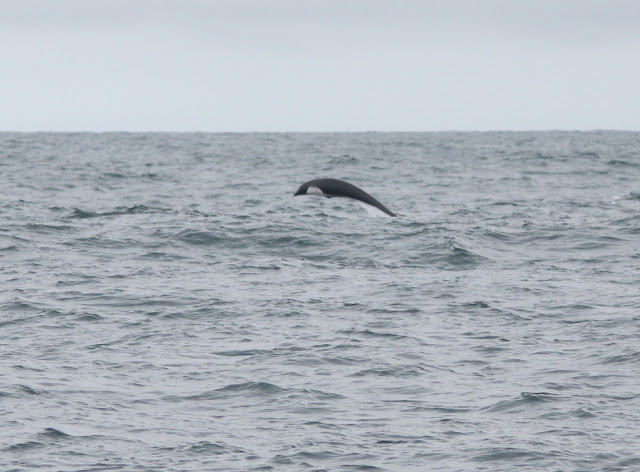It is separated from other black and white albatross by the smaller size, the black back that extends down the back a bit (forming a white U), and..
a variable smudgy underwing and a pink bill with a nice blue tip.
Lots of Red Phalarope were seen. It is easy to separate these from Red-necked in breeding plumage even at a great distance, Red have dark bellies,
while Red-necked have white bellies and the white cheek.
One very cooperative Tufted Puffin was spotted.
Pink-footed Shearwater were common farther off shore. They molt their wings Apr-Aug, non breeders molt earlier. I spent the day trying to see which primaries were being molted. Shearwater, like others, shed their inner primaries all at once. So I think this bird just started its molt since I do not see any new primaries poking out from the coverts yet.
Most of the birds I studied were the thousands of Sooty Shearwater we spotted. Here I think I see the new inner primaries growing in, those darker feathers on inside of the gap. Once molt reaches the middle primaries, the coverts are shed. This creates that bold white wing stripe, those are the bases of exposed feathers.
I think this one just started on the inner primary molt.
When I saw this bird, I thought I had found a bird with no molt, so I was thinking a first-year bird. But when I looked at the photo, I think I see new middle primaries? So this one is well into its molt, I think I see new coverts growing in as well. If I read things write, a bird this far along might be a non-breeder or a second-year bird? All this molt stuff might be complete bull, trying to figure it out myself. In any case there is always lots of interesting things to look for on these trips. I thought I saw other birds with no molt, but no good photos obtained.
Two Parasitic Jaegers did a fly-by for us.
My goal on these trips was to find a petrel offshore, none seen this year. A nice plus on Saturday's trip were all the mammals we saw. I can't recall when we saw them first, but I would guess from 20ish miles offshore out to 35 miles or so offshore, the ocean was packed with whales and dolphin. So while scanning the skies for a petrel, the mammal show kept me entertained.
You can see the hump where the dorsal fin sits on this Humpbacked Whale.
Pacific White-sided Dolphin were everywhere, out enjoying the day.
I am always amazed at how stream-lined they are, they can come a good ways out of the water without actually breaking the surface.
One of my favorite beasts is the Northern Right Whale Dolphin. they have a beautiful white patch on their underside.
And, like whom they are named after, the Northern Right Whale, they lack a dorsal fin.
At one point I spotted some high dorsal fins in the water, I thought small Orca, but they seemed a tad small. Risso's Dolphin is the other option.
Some were resting on the surface, they stayed in an eerie pattern, I felt like I was watching a sea monster from Pirates of the Caribbean.
Their backs and bodies become scarred from their fellow dolphin's teeth or from the squid that they feast upon. The older they get, the paler they get. That is an older one in front.
We saw well over 100 of these amazing dolphin. Their dorsal fin usually remain dark.
They always have very striking patterns on their bodies.
Overall the boat (Monte Carlo) traveled 87 miles, I did not see a tern until mile 86.999, just as we were getting back to marina. Common Tern.
Thanks to the boat, the crew, Phil and Chris, and the spotters, Bill, Bruce, Scott and Mike. Will post ebird results once they are done. Thanks for the visit. Ochocos next weekend then Malheur in 9 days!

























































